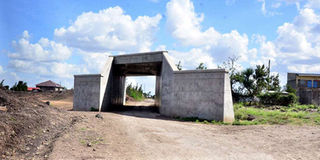Rongai locals accuse SGR contractor of altering road design

This image taken on January 12, 2019 shows the bridge constructed in Olooltepesi sub-location, Kajiado County, to aid the Standard Gauge Railway. PHOTO | FRANCIS NDERITU | NATION MEDIA GROUP
What you need to know:
- Residents are now demanding that the SGR contractor stops work at the affected sections until their concerns are addressed.
- The concerns raised by the residents, unless handled expeditiously, could further delay the completion of Phase 2A of the SGR project.
Residents of a village in Ongata Rongai, Kajiado County, have accused the Chinese contractor of Phase 2A of the Standard Gauge Railway (SGR) of illegally altering the designs of a major road in the area.
In a letter dated January 7, 2019, the Oloosirkon Residents Association (ORA) petitions the managing director of the Kenya Railways Corporation “to urgently intervene and stop the intentions of the SGR contractor to permanently block and alter the design and nature of the Ongata Rongai-Kitengela Road (the Greater Southern bypass).”
The association claims that the original design of the SGR route had provided for the construction of an overhead bridge (at point DK12-035) — which is near Tuala trading centre — for the SGR, across the road.
“Instead of following this important provision, the contractor has decided, without any consultation with the community to build a permanent 12-metre high concrete embankment across the road, thereby completely blocking and altering the nature of the road,” ORA said in a letter signed by their chairman Mr Awori Achoki and Mr Philip Kulangash, who signed on behalf of the local community.
SAFETY
To alter the design of the road, ORA claims in their petition that the contractor created a sharp right angle diversion one kilometre from Tuala town into two five metre-wide tunnels.
“The road emerges from the tunnel into another sharp right angle turn to the left — 10 metres from the tunnel. The hazard posed by these reckless design provisions is unimaginable,” the letter says.
They further complained that the SGR contractor — China Communications Construction Company (CCCC) — had made significant modifications in to the nature of the road, including reducing the width from the original 25 metres to 10 metres.
“Vehicles entering the tunnel from either direction are not visible to the driver until one is inside the tunnel. The sharp angle turn does not allow for gradual safe manoeuvring by large vehicles such as lorries and buses into the tunnel,” the letter claims.
PUBLIC INTEREST
The road is the only major link between Ongata Rongai and Kitengela towns and is a key component of the Nairobi metropolitan Transport Authority’s plan to decongest Nairobi city.
The ministry of Transport and Infrastructure tendered for the tarmacking of the road in 2017.
The residents are now demanding that the SGR contractor stops work at the affected sections until their concerns are addressed as well as other emerging issues of public interest.
“We demand to know why a major public road has been diverted into private land at a great cost to the public while adequate land for its expansion and development had been reserved by the government,” the ORA letter says.
Two-day efforts to get comment from the Kenya Railways Corporation Acting Managing Director Philip Mainga were not successful as he did not answer our calls or answer the text messages we sent to his mobile phone.
TIMELINE
Mr Luka Kimeli, the acting director-general of the Kenya Rural Roads Authority, (KeRRA) said, in a text message, “I will need to confirm whether the road is a county road or national government road before providing a response.”
The concerns raised by the residents of Oloosirkon, unless handled expeditiously, could further delay the completion of Phase 2A of the SGR project, which runs from Nairobi to Naivasha.
In a press statement sent to newsrooms on Friday, Mr Mainga said that construction work on the 120-kilometre route is 88 percent complete and is scheduled to be completed by May 30, 2019 and will be officially launched the following day.
The project experienced delays over acquisition of land. To date a total of Sh17.6 billion has been used to compensate land owners affected by the project.
“I want to assure Kenyans that they will begin enjoying our train services, both passenger and freight from Mombasa to Mai Mahiu from June 1, 2019,” said Mr Mainga.
COST
Work on the Nairobi-Naivasha section of the SGR began in January 2017 at a cost of Sh150 billion.
The first phase from Mombasa to Nairobi was completed in June 2017 at a cost of Sh327 billion.
Majority of the funding for the project has come from the Exim Bank of China. Phase 2B of the project from Naivasha to Kisumu will cost Sh350 billion, the bulk of which is expected to be financed through loans from the same lender.





